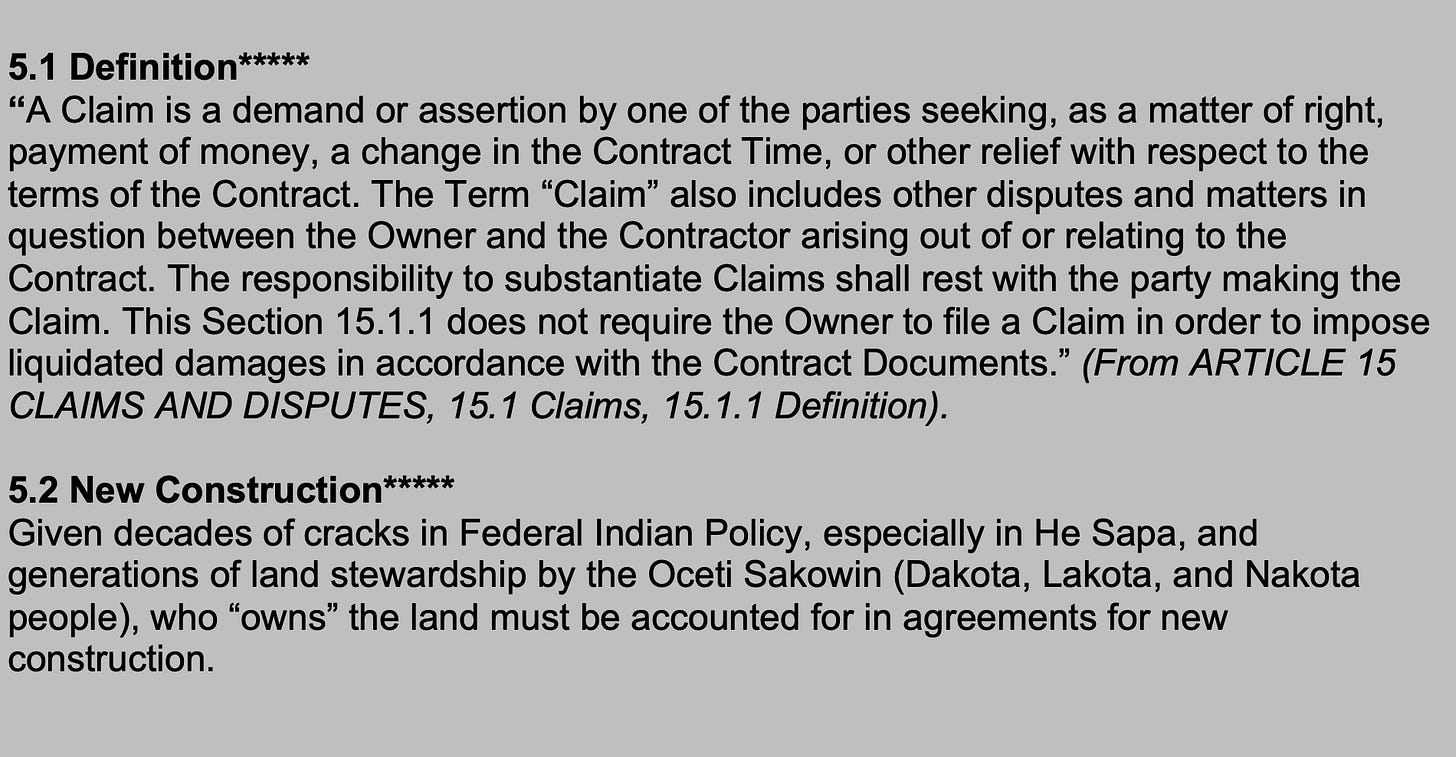Illegal Architecture
An Amended Contract for US Architects and Educators
by Jessica Garcia Fritz
Contracts are designed to exclude. When considering the framework for current legal and social contracts in the US, especially in Architecture, the copy and paste mode of contract writing reproduces systemic barriers that platforms such as “Support Structures” unmask. What follows is the exposure of the settler colonial practices that AIA Contract Documents reproduce. By replicating direct text from the “AIA Document A201—2017 General Conditions of the Contract for Construction,” adding language to situate the ideological context, and writing disclaimers that dispute contractual anomalies, the architecture and construction in places such as He Sapa (Black Hills) are exposed as questionably ‘illegal’ in Lakota lands. Ultimately, the ‘new’ contract highlights how current contract documents continue to uphold dispossession in indigenous lands.
ARTICLE 1 GENERAL PROVISIONS
*Disclaimer on Contracts
Agreements will be broken. For over a century, construction contracts in the United States have and continue to uphold the general provisions and relationships on a building site, but do not consider who has and continues to steward the site and surrounding lands. This stewardship was originally acknowledged through treaties made between indigenous nations and the US. Many of these agreements have been broken and replaced with individual rights of the “Owner.”
ARTICLE 2 OWNER
**Disclaimer on Property
Owning property is an ideology. US contract documents continue to prioritize the owner’s control and decision-making power, ensuring that the economic risks are distributed according to an established hierarchy, and benefits accrue to the owner’s property. Because these ideologies originated in documents such as the 1888 Uniform Contract, a format written alongside the public and private land expansion of the U.S in the nineteenth century, its credence continues to uphold theft in indigenous lands, especially ownership of a “site.”
ARTICLE 3 CONTRACTOR
***Disclaimer on Stolen Sites
Treaties are (somehow) not applicable law. This is implied when considering “use of site.” Dakota scholar Elizabeth Cook-Lynn writes about US expansion as a series of illegal land claims by fore fronting the explicitly egregious He Sapa (Black Hills) land theft in Lakota Lands. This includes the 1877 Black Hills Act, which allowed US Congress to poach seven million acres of Sioux nation lands. One-hundred years later, the “US Supreme Court described this Congressional Act thus: ‘A more ripe and rank case of dishonorable dealings will never, in all probability, be found in our history.’ The Court made it clear that the Act must be called a ‘theft’ in legal terms, not a ‘taking’.” [Elizabeth Cook-Lynn, A Separate Country: Postcoloniality and American Indian Nations (Lubbock, TX: Texas Tech University Press, 2012), 142.] The applicable and governing laws for these sites are confused.
ARTICLE 4 MISCELLANEOUS PROVISIONS
Governing Laws may be paradoxical. Construction in He Sapa continues, despite the suspended legal status of the lands. Because contract documents for construction reflect U.S. national ideologies, an ownership exception like He Sapa is unaccounted for in the AIA’s templated formats.
ARTICLE 5 CLAIMS AND DISPUTES
*****Disclaimer on Land Dispossession
Architectural Contracts continue to uphold land dispossession. Architectural documents, agreements, and contractual frameworks in the US reinforce settler-colonial systems by establishing ownership, exerting power through arcane governance, and undermining treaty rights. For contractual documents to account for transgressions like these, they must shift from transactional relations of single-entity ownership and management toward multi-party stewardship as the basis of relations.
Jessica Garcia Fritz (she/her) is an Assistant Professor in the School of Architecture, the Design Justice liaison for architecture in the College of Design, an Affiliate Faculty for American Indian Studies at the University of Minnesota, and co-director of LAB-OR. As a citizen of the Cheyenne River Sioux Tribe (Itazipco Lakota), her cross-disciplinary teaching and research challenge architecture’s role in nation-state building through specification writing and the extraction of material territories in indigenous lands. Her research on specification writing has been published in the Technology Architecture and Design Journal (TAD) and two editions of Building Knowledge, Construction Histories (CRC Press). Recent publications include The Organizers Guide to Architecture Education, a coauthored book that reorients architecture education toward a stewardship of the planetary commons, as well as a book review and conversation with Oceti Sakowin writers in SAIL.





